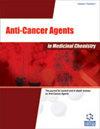Synthesis of a Novel Gold(I) Complex and Evaluation of Its Anticancer Properties in Breast Cancer Cells
IF 2.6
4区 医学
Q3 CHEMISTRY, MEDICINAL
Anti-cancer agents in medicinal chemistry
Pub Date : 2024-02-02
DOI:10.2174/0118715206281182231127113608
引用次数: 0
Abstract
Background: Platinum complexes are commonly used for cancer chemotherapy; however, they are not only highly-priced but also have various side effects. It is, therefore, important to design affordable anticancer drugs with minimal side effects. background: Platinum complexes are commonly used for cancer chemotherapy however they are not only highly priced but also have various side effects. It is therefore important to design affordable anticancer drugs with minimal side effects. Methods: We synthesized a new gold(I) complex, PF6{(BDPEA)(TPPMS) digold(I)} (abbreviated as PBTDG) and tested its cytotoxicity of MCF-7 breast cancer cells. We also evaluated the effects of PBTDG on mitochondrial membrane potential, generation of reactive oxygen species (ROS) and apoptosis in breast cancer cells. objective: To synthesize a novel gold(I) complex and test its cytotoxicity and apoptotic potential in MCF-7 breast cancer cells. Results: The IC50 values for PBTDG and sorafenib were found to be 1.48 μM and 4.45 μM, respectively. Exposure to PBTDG caused significant and concentration-dependent depletion of ATP and disruption of mitochondrial membrane potential. PBTDG induced 2.6, 3.6, and 5.7-fold apoptosis for 1 μM, 3 μM, and 10 μM concentrations, respectively. The induction of apoptosis by the same concentrations of sorafenib was 1.2, 1.3, and 1.6-fold, respectively. The low concentration of PBTDG (1 μM) induced the generation of ROS by 99.83%, which was significantly higher than the ROS generation caused by the same concentration of sorafenib (73.76%). The ROS induction caused by higher concentrations (5 μM) of PBTDG and sorafenib were 104.95% and 122.11%, respectively. method: We synthesized a new gold(I) complex, PF6{(BDPEA)(TPPMS)digold(I)} (abbreviated as PBTDG) and tested the cytotoxicity in MCF-7 breast cancer cells using MTT assay. We used spectrophotometry for ATP analysis and flow cytometry for mitochondrial potential, apoptosis and ROS analyses. Conclusion: The lower concentration of PBTDG produced similar cytotoxicity and apoptotic effects that were caused by a comparatively higher concentration of known anticancer drug (sorafenib). The anticancer effects of PBTDG are attributed to its tendency to disrupt mitochondrial membrane potential, induction of apoptosis and generation of ROS. Further studies are warranted to test the anticancer effects of PBTDG in animal models of cancer. result: The IC50 values for PBTDG and sorafenib were found to be 1.48 μM and 4.45 μM, respectively. Exposure to PBTDG caused significant and concentration-dependent depletion of ATP and disruption of mitochondrial membrane potential. PBTDG induced 2.6, 3.6, and 5.7-folds apoptosis for 1 µM, 3 µM, and 10 µM concentrations, respectively. The induction of apoptosis by same concentrations of sorafenib was 1.2, 1.3, and 1.6-folds, respectively. The low concentration of PBTDG (1 µM) induced the generation of reactive oxygen species (ROS) by 99.83% which was significantly higher than the ROS generation caused by the same concentration of sorafenib (73.76%). The ROS induction caused by higher concentration (5 µM) of PBTDG and sorafenib were 104.95% and 122.11%, respectively. other: Further studies are warranted to test the anticancer effects of PBTDG in animal models of cancer.一种新型金(I)配合物的合成及其在乳腺癌细胞中的抗癌性能评估
背景:铂络合物常用于癌症化疗;然而,它们不仅价格昂贵,而且有各种副作用。因此,设计副作用最小、价格合理的抗癌药物非常重要:铂络合物常用于癌症化疗,但它们不仅价格昂贵,而且有各种副作用。因此,设计价格合理、副作用最小的抗癌药物非常重要。方法:我们合成了一种新的金(I)复合物 PF6{(BDPEA)(TPPMS) digold(I)}(简称 PBTDG),并测试了它对 MCF-7 乳腺癌细胞的细胞毒性。我们还评估了 PBTDG 对线粒体膜电位、活性氧(ROS)生成和乳腺癌细胞凋亡的影响:合成一种新型金(I)复合物,并测试其对 MCF-7 乳腺癌细胞的细胞毒性和凋亡潜能。结果发现 PBTDG 和索拉非尼的 IC50 值分别为 1.48 μM 和 4.45 μM。暴露于 PBTDG 会导致 ATP 的显著消耗和线粒体膜电位的破坏,且呈浓度依赖性。浓度分别为 1 μM、3 μM 和 10 μM 的 PBTDG 可诱导 2.6 倍、3.6 倍和 5.7 倍的细胞凋亡。相同浓度的索拉非尼对细胞凋亡的诱导分别为 1.2 倍、1.3 倍和 1.6 倍。低浓度 PBTDG(1 μM)诱导产生的 ROS 为 99.83%,明显高于相同浓度索拉非尼诱导产生的 ROS(73.76%)。更高浓度(5 μM)的PBTDG和索拉非尼引起的ROS诱导率分别为104.95%和122.11%:我们合成了一种新的金(I)复合物--PF6{(BDPEA)(TPPMS)digold(I)}(缩写为 PBTDG),并用 MTT 法检测了其对 MCF-7 乳腺癌细胞的细胞毒性。我们使用分光光度法进行 ATP 分析,使用流式细胞仪进行线粒体电位、细胞凋亡和 ROS 分析。结论较低浓度的 PBTDG 产生的细胞毒性和凋亡效应与较高浓度的已知抗癌药物(索拉非尼)相似。PBTDG 的抗癌作用归因于其破坏线粒体膜电位、诱导细胞凋亡和产生 ROS 的倾向。有必要进一步研究 PBTDG 在癌症动物模型中的抗癌效果:发现 PBTDG 和索拉非尼的 IC50 值分别为 1.48 μM 和 4.45 μM。暴露于 PBTDG 会导致 ATP 的显著消耗和线粒体膜电位的破坏,且呈浓度依赖性。浓度为 1 µM、3 µM 和 10 µM 的 PBTDG 可分别诱导 2.6 倍、3.6 倍和 5.7 倍的细胞凋亡。相同浓度的索拉非尼诱导的细胞凋亡分别为 1.2、1.3 和 1.6 倍。低浓度的 PBTDG(1 µM)诱导产生的活性氧(ROS)为 99.83%,明显高于相同浓度的索拉非尼诱导产生的 ROS(73.76%)。更高浓度(5 µM)的 PBTDG 和索拉非尼引起的 ROS 诱导率分别为 104.95% 和 122.11%:有必要进一步研究 PBTDG 在癌症动物模型中的抗癌效果。
本文章由计算机程序翻译,如有差异,请以英文原文为准。
求助全文
约1分钟内获得全文
求助全文
来源期刊

Anti-cancer agents in medicinal chemistry
ONCOLOGY-CHEMISTRY, MEDICINAL
CiteScore
5.10
自引率
3.60%
发文量
323
审稿时长
4-8 weeks
期刊介绍:
Formerly: Current Medicinal Chemistry - Anti-Cancer Agents.
Anti-Cancer Agents in Medicinal Chemistry aims to cover all the latest and outstanding developments in medicinal chemistry and rational drug design for the discovery of anti-cancer agents.
Each issue contains a series of timely in-depth reviews and guest edited issues written by leaders in the field covering a range of current topics in cancer medicinal chemistry. The journal only considers high quality research papers for publication.
Anti-Cancer Agents in Medicinal Chemistry is an essential journal for every medicinal chemist who wishes to be kept informed and up-to-date with the latest and most important developments in cancer drug discovery.
 求助内容:
求助内容: 应助结果提醒方式:
应助结果提醒方式:


